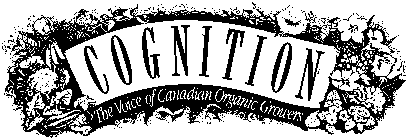

Cognition Index | Virtual Library
| Magazine Rack
Search
| Join the Ecological Solutions Roundtable
COG Organic Field Crop Handbook
3.10 Spelt Spelt, (Triticum spelta L), originated and became established around 3,000 B.C. in the area that is now Switzerland and southern Germany. It was a very important bread grain in its time. Spelt acreage declined after the Second World War when high quantities of grain became a priority. Acreages of organic spelt have recently increased responding to a demand for the health food market. The grain can often be tolerated by individuals who suffer from wheat allergies.
Spelt has a protein content of between 12 and 15 percent. It has a strong hull which tightly encloses the kernal protecting the seed from disease and mechanical damage. The kernal itself has a thin skin.
Spelt will out-yield wheat in pounds/acre, but this is due to the weight of the glumes or hulls which account for about 30-40 percent of the total weight.
Reasons for crop selection
Spelt is a winter cereal and will protect the soil from wind and water erosion* Market
Spelt as a cash crop is in high demand because of its high nutritionalvaleie. It is bought by people who suffer from wheat allergies as it is easily digested.
* Nutrient benefit
Spelt is grown at the n
. It has
wheat. It is winter hardy and can be sown at the same time as winter wheat. uefor itsibilitySpelt is a low feeder of nutrients and provides excellent ground cover over the winter.
* Straw
Spelts produces large quantities of straw.
* Nutrition
Nutrient shortages in spelts would appear similar to those in winter wheat. Generally, there is not a problem, but manganese deficiency can occur when the grain is grown in soil with a high organic content. The symptoms of managanese deficiency are leaves appearing light yellow in colour while the vein area remains green.
Spelt will out-yield wheat in pounds per acre, but this is due to the weight of the glumes or hulls which accounts for about 20 percent. (1-2.5 inches)
accomodate this high rate of seeding, many farmers seed in one
Variety selection is very limited due to a lack of interest in and knowledge of the crop. One variety called Ober Kulmer Rotkorn, constitutes about 80 to 90 percent of all spelt planted in Ontario.
Planting methods
Soil preparation should begin in mid September, or when it is normal for the soil to be prepared for planting winter wheat in your area. The seed bed should not be too fine.
Seeding Rate : 180-200 kg/ha at a depth of 3 to 7 cm.
If the planting date is delayed increase the seeding rate by ten percent.
As most seed drills cannot accommodate this high rate of seeding many farmers seed in one direction ,then cross the field again in the opposite direction. Make sure the seed is covered, if necessary harrow after seeding.
Crop management
If the spelt did not have a good germination in the fall, a spiked tooth harrow should be used to encourage side shoots (tillering) to fill in the spaces.
* Underseeding
Red clover can be broadcast into spelt (10 lb/acre), in the early spring as soon as conditions allow since spelt is vigorous and fast growing.
.
* Weed and pest control
Because spelt is a fall crop, it is not prone to severe weed problems. With only small acreages being grown, knowledge of pest and disease problems is limited, and monitoring the field is advisable.
Harvesting
Harvesting usually starts eight to ten days before the normal winter wheat harvest. Spelt is ready for harvest when the straw is completely yellow and the kernels can break cleanly when cracked. Without being swathed, the spelt is combined with the cylinders fully open, the wind speed reduced, and the cylinder speed set slow in order to avoid dehulling. Spelt is easy to combine but the kernals must not be thrashed out if their hulls. Dehulling is done seperately.
Suitable following crops
Since spelt is harvested so early, it can easily be followed by either oil radish or buckwheat cover crops which are seeded into the stubble. A spring cereal is usually planted the following year.
Copyright © 1992 Canadian Organic Growers. Inc
Reprinted with permission. All rights reserved.
How to order the COG Field Crop Handbook:
Info Request | Services | Become EAP Member | Site Map
Give us your comments about the EAP site
Ecological Agriculture Projects, McGill University (Macdonald
Campus)
Ste-Anne-de-Bellevue, QC, H9X 3V9 Canada
Telephone:
(514)-398-7771
Fax:
(514)-398-7621
Email: info@eap.mcgill.ca
To report problems or otherwise comment on the structure of this site, send mail to the Webmaster